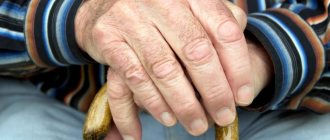Apraxia is a disease that is characterized by impairment in the performance of goal-directed actions.
At the same time, despite the fact that there is a desire, as well as physical ability, a person cannot perform any gestures or body movements. In addition, the disease proceeds in such a way that there are completely no disturbances in coordination, as well as signs of paresis.
The disease affects the cerebral hemispheres and along with it the pathways of the corpus callosum. Apraxia can develop as a result of a number of pathologies, and currently experts divide the disease into several types, which are distinguished depending on certain factors, such as location and others.
Some forms of the disease can only be diagnosed by observing a person perform certain tasks. Thus, as an example, we can note the loss of skills:
- drawings that were previously present;
- write;
- tie shoelaces;
- playing a musical instrument and others.
Treatment of apraxia in Saratov, Russia, therapy of apraxia
Sarklinik provides treatment for certain types of apraxia in adults, adolescents, children, boys, girls, boys, girls, men, women in Saratov, Russia. The doctor knows how to treat apraxia , how to cure apraxia, how to get rid of apraxia, what to do with apraxia, where to go. At the first consultation, will the doctor tell you what types of apraxia there are? What are the characteristics of kinesthetic (kinetic) apraxia, aphasia and agnosia ? Why does oral apraxia, motor apraxia, constructive apraxia, articulatory apraxia, regulatory apraxia occur in children and adults? What is apraxia of walking and speech? What is the danger of motor left, right hand, left, parva leg, fingers, ideator apraxia? What are the principles for diagnosing apraxia ? Unfortunately, traditional methods, traditional medicine, diet, pills, medicines, drugs, traditional methods, spells, homeopathy rarely help in the treatment of apraxia. On the website sarclinic.ru you can see a doctor online for free.
Sign up for a consultation. There are contraindications. Specialist consultation is required.
Related posts:
Where in Saratov you can cure your nerves
Neurologist neuropathologist difference, what is different, what treats what diseases
Nocturnal enuresis code according to ICD 10 F 98.0
Decerebrate rigidity: causes, symptoms, treatment
Hormetonia, Davidenkov's hormetonic syndrome
Comments ()
Apraxia
Apraxia (from the Greek a - prefix of negation, praxis - action) is a loss of memory of motor skills in the form of an inability to voluntarily perform sufficiently subtle purposeful actions while maintaining muscle strength and the ability to perform elementary motor acts. H. Liepman (1900), who first described apraxia, identified kinetic apraxia of the limbs, ideomotor apraxia, ideational apraxia and agraphia. Later, some other forms of apraxia became known. Apraxia deprives the patient of the practical ability to perform not only complex, but also the simplest skills, such as shaking hands, combing one's hair, lighting a match, fastening a button, etc. Manifestations of apraxia are difficult to clearly describe.
1. Kinetic apraxia of the limbs (acrokinetic motor apraxia) - loss of memory of skills of simple actions, including gestures. The patients' movements are awkward, imprecise, and seem to be inconsistent with a specific goal. Apraxia is unilateral and is associated with diffuse contraction of agonist and antagonist muscles. In the case of apraxia of gestures, the performance of elementary actions that are included in these gestures is impaired. Thus, the gesture “wagging a finger” is performed by moving the index finger in the sagittal plane. The disorder occurs when the left parietal lobe is damaged in the area bordering the posterior postcentral gyrus.
| | Apraxia can be caused by primary and symptomatic psychoses |
Kinesthetic apraxia (Liepmann, 1905; Heilbronner, 1905) is a form of acrokinetic motor apraxia. It is characterized by the loss of kinetic and kinesthetic images of limb movement. Patients cannot apply the required force when moving their fingers and hands, or accurately direct such efforts, which is why they become rough and undifferentiated. This disorder is associated with a lesion in the area of the anterior and posterior central gyri.
Innervatory or premotor apraxia (Kleist, 1907) is manifested by the loss of the ability to perform complex and subtle actions developed through long-term life practice. Violations concern one limb or even part of it. Occurs when the premotor area of the frontal cortex is damaged. In addition, bimanual apraxia has been described (Brown, 1972), with its inherent difficulties in patients performing complex objective and symbolic actions that require the combined work of both hands. The actions of each hand separately are not impaired (Ovcharova, Raitsev, 1980).
2. Ideomotor apraxia (Dejerine's execution apraxia) - loss of the ability to perform actions on command from the outside. The patient is able to describe the plan for this or that action, he can automatically perform it on his own (for example, light a match and smoke), but he cannot perform this action on command, or by imitation. At the same time, he seems to forget exactly what movements need to be made to carry out the action. The performance of actions in the absence of appropriate objects is especially severely impaired. For example, the patient cannot show how to cut wood, stir sugar in a glass of tea with a spoon, hammer a nail, etc.
Purposeful actions become deformed and diffuse, as they include movements from other actions. At the same time, synkinesis occurs. Meanwhile, symbolic actions are still performed without difficulty and correctly. Bilateral ideomotor apraxia most often occurs with damage to the supramarginal gyrus of the left parietal lobe. Less commonly, this occurs with right-sided damage to the parietal lobe, and apraxia is limited to the left limbs. Ideomotor apraxia in right-handers also occurs with right-sided damage to the parietal region, as well as when the source of damage is localized in the middle parts of the corpus callosum.
| | If you have signs of apraxia, we recommend that you contact a psychiatric clinic and undergo diagnostics. |
Kinetic (ideokinetic) and ideomotor apraxia are considered as variants of motor apraxia. Motor apraxia is generally characterized by perseveration of movements and disruption of the sequence of movements.
3. Ideatorial apraxia (apraxia of intention) is associated with the loss of memory traces of the desired image of an action or with the loss of the ability to detect this image in memory. Rarely found in isolated form. It is usually bilateral and affects all parts of the body. The patient seems to forget what and how the objects around him can be used. He can, however, repeat the doctor’s actions or correctly perform any fragment of the action, but he may not be able to independently carry out a complex sequence of movements.
For example, he cannot take a box of matches, remove one match from it, close the box, light the match, then light the candle and finally extinguish the match. Instead, understanding what they want from him, he turns the box for a long time, scratches the match on the other side of the box or with the wrong end of the match, puts an unlit match in his mouth, etc. Occurs when the angular and, partially, supramarginal gyri of the dominant hemisphere are damaged ( for right-handers - left). Ideatorial apraxia is almost always combined with elements of sensory aphasia, and sometimes with the phenomena of hemiplegia and hemianopsia (Khodos, 1974). Varieties of ideation apraxia include oral apraxia, trunk apraxia and dressing apraxia.
Oral apraxia is manifested in patients by the loss of the ability to perform simple articulatory postures as instructed, such as sticking out the cheek with the tongue, placing the tongue under the upper or lower lip, touching the corners of the mouth or upper lip with the tongue, etc. In addition, the intentional execution of externally required tasks suffers. symbolic actions such as clicking, whistling, spitting, smacking, etc. - symbolic apraxia. Swallowing apraxia is very rarely detected (some researchers classify it as facial apraxia). Patients perform all of these actions spontaneously, however, during eating, speaking, and communicating. Oral and symbolic apraxia usually accompany motor apraxia. The disorder occurs when the lower parts of the postcentral gyrus of the dominant hemisphere are damaged, probably involving adjacent areas of the parietal lobe.
Apraxia of the trunk is characterized by loss of the ability to properly position the trunk and legs in order to stand, walk, and sit. Also designated by the term astasia-abasia. Movements in the legs, meanwhile, are preserved in full. It occurs when the parietal region is damaged in both hemispheres, often with a disruption of its connection with the visual thalamus.
Apraxia of dressing (Brown, 1941) is characterized by the loss of the ability to carry out the sequence of actions with clothing in order to dress and undress. Patients cannot correctly associate items of clothing with parts of their body. When putting on a shirt, for example, the patient tries to pull it over his head, but at the same time sticks his left hand into the right sleeve. Or puts on a shirt buttoned back. He performs similar actions with other clothes, shoes, and hats. It is observed with damage to the angular gyrus of the parietal lobe of the left hemisphere.
Agraphia (from the Greek a - particle of negation, grapho - to write) is a violation of the ability to write. Apractical agraphia is a variant of ideatorial apraxia, when the idea of the movements necessary for writing is lost. Agraphia constructive (Kleist, 1934) is manifested by the inability to write legibly from memory or from a model. Motor agraphia is associated with paralysis. Pure agraphia is caused by damage to the posterior parts of the second frontal gyrus of the dominant hemisphere.
The neuropsychology of apraxia is presented somewhat differently in the works of A. R. Luria (1974).
The author distinguishes between these types of apraxia.
1. Kinetic or afferent apraxia is characterized by a main defect in the form of a violation of proprioceptive kinesthetic afferentation. The patients' movements are undifferentiated and poorly controlled. When shaking hands, the “shovel hand” symptom is observed, when the hand is presented straight, as if not ready for this action. Writing movements are impaired, various hand postures are not reproduced (signs of approval, disagreement, etc.) - postural apraxia. Actions without objects are difficult: the patient cannot show, for example, how to pour water into a glass. Visual control somewhat improves the execution of actions. The disorder occurs when the parietal lobe is damaged near the lower parts of the postcentral gyrus. When affected on the left, the disorder is bilateral; on the right, it affects only the left hand.
2. Spatial apraxia is based on a violation of the visual-spatial afferentation of movements. Typical symptoms include postural apraxia and difficulty performing spatially oriented movements. There is no clear difference when performing movements with open and closed eyes.
3. Constructive apraxia (Krol, 1933; Kleist, 1934) is characterized by impairments in drawing and constructing figures from parts. Patients cannot draw simple geometric figures, objects, animals and humans from memory in a recognizable or accurate manner. Drawing from memory is especially difficult. Patients incorrectly select a place on a sheet of paper to draw according to the pattern. In this case, a symptom of inclusion is revealed - they place their drawing close to the sample or superimpose it on the latter. The left field of space is often ignored. When constructing (from sticks, cubes), patients cannot put together a certain figure according to the proposed model. The violation of copying is especially noticeable when it comes to unnamed (“non-verbal”) figures. The last technique is used to identify hidden constructive apraxia. The disorder occurs when the angular gyrus of both the left and right hemispheres is damaged. In right-handers, impairments with left-sided damage are more pronounced. According to other sources, the lesion is located in the inferior parietal and parieto-occipital regions of the dominant hemisphere.
4. Kinetic apraxia is characterized by a violation of the sequence of motor acts. Motor perseverations are typical, patients seem to get stuck on performing some movement, being unable to move on to the next one. Actions with objects, drawing, writing, and performing graphic tests, especially those associated with series of movements, are impaired—dynamic apraxia.
5. Regulatory apraxia is manifested by a violation of voluntary control of motor acts, including speech. As a result, expedient actions are replaced by stereotyped ones. Some motor programs—systemic perseverations—can be reproduced mechanically in their entirety. Particular difficulties arise for patients in situations of changing the program of action. The disorder is associated with a focus of damage in the convexity prefrontal cortex, especially on the left. Severe damage is manifested by echopraxia.
In the literature there is a description of other variants of praxis violation; we will indicate some of them.
Akinetic apraxia is manifested by the loss of the ability to perform voluntary actions due to a lack of motor initiative and motivation to be active.
Ocular apraxia is characterized by the loss of the ability to fixate the gaze on a specific object. At the same time, the patients’ gaze continuously wanders, it constantly moves from one object to another.
Amnestic apraxia is manifested by the loss of the ability to perform sequential actions at the request of the outside. It is due to the fact that patients forget about what next action they have to perform.
Limb apraxia is characterized by loss of conscious control over arm movements. It manifests itself: 1) by movements of the wrong hand that should perform the action, 2) by incorrect movements of the correctly chosen hand, and 3) by correct movements of the hands in the wrong sequence.
Perseveratory apraxia is manifested by the loss of the ability to act purposefully due to motor perseverations. Occurs when the frontal cortex of the brain is damaged. Apraktoagnosia (from the Greek apractos - useless, inactive, a - particle of negation, gnosis - knowledge, cognition) is characterized by a combination of apraxia, primarily constructive, and agnosia. Two variants of the disorder have been described. The first is Hecaen's syndrome (Hecaen, 1956). Left-sided spatial agnosia, visual-constructive disorders, apraxia of dressing, disturbance of topographical ideas and concepts, hemisomatognosia, dyslexia and acalculia are observed.
The disorder occurs when the lesion is localized in the right hemisphere (supramarginal and angular gyri, posterior part of the superior temporal gyrus). The second option is Zangwill syndrome (Zangwill, 1950). This disorder is characterized by the following symptoms: 1) ignoring the left half of visual space, that is, unilateral spatial agnosia, 2) constructive apraxia, 3) impaired topographic memory and spatial disorientation, 4) apraxia of dressing, and 5) oculomotor disorders and defects in visual coordination. The disorder occurs when the right hemisphere of the brain is damaged.
Alexia (from Greek a - prefix of negation, lexis - word, speech) - loss of the ability to read. The disorder may be associated with the following factors: inability to distinguish letters - literal alexia, inability to distinguish syllables - asyllabia, and inability to distinguish words - verbal alexia. The dynamics of the disorder are characterized by the following sequence of violations. The lesion is localized in the basal cortex of the occipital lobe of the dominant hemisphere. In some cases, the damage extends to the temporal cortex of the brain (Smirnov, 1962). The ability to write is lost. With pure alexia, patients cannot read what they themselves have written.
Alalia (from Greek a - prefix of negation, lalia - speech) or aphemia - loss of the ability to speak. Described by Delius (1757). Depending on whether expressive or impressive speech suffers, motor and sensory alalia are distinguished. Observed in childhood. It is caused by underdevelopment of the speech areas of the brain, their pre- or early postnatal damage. When motor alalia is impaired or absent, active speech may not be affected by understanding the speech of others. Sensory alalia is characterized by the timely appearance of speech activity and misunderstanding of the speech of others. Some authors use the term to designate functional speech disorders, preferring to define organic ones with the term “aphasia.” The inability to speak due to spasms of the speech muscles is called aphtensia.
Acalculia or dyscalculia (from Latin a - prefix of negation, calculo - to count; Greek dys - prefix meaning negation, separation, division). Described by SEHenschen (1919). Characteristic are counting disorders, especially those associated with passing through tens, the inability to grasp or loss of understanding of the place value structure of numbers. There are very local violations when the patient, for example, adds numbers correctly, but does not know how to subtract. The disorder is explained by a violation of simultaneous synthesis (Luria, 1962), which occurs when the parieto-occipital region of the dominant hemisphere is damaged. In rare primary acalculia (Berger, 1926), the disorder is not associated with a disorder of other higher cortical functions. With secondary acalculia, the disorder occurs in combination with a general decrease in memory, the phenomena of aphasia and perseveration.
Azaphia or azathololalia (from the Greek a - prefix of negation, saphes - clear) - slurred, indistinct speech. A rarely used synonym for motor aphasia and dysarthria. Akatamasesia (from the Greek a - prefix of negation, katamothesis - complete knowledge) is a complete inability to understand spoken language. Caused by sensory aphasia, it is also observed in acute psychotic states.
Aprosody or disprosody (from the Greek a, dys - prefixes of negation, prosodikos - relating to stress) is the inability or loss of the ability to master the prosodic characteristics of speech, such as stress, tonality, volume, pauses. Usually accompanies aphasia and in this case is associated with pathology of the frontal cortex of the brain, presumably the subdominant hemisphere. It can also occur with other disorders, such as affective ones.
Apsithyria (from the Greek a - prefix of negation, psithyros - whisper) - the inability or loss of the ability to speak in a whisper. Probably one of the manifestations of aprosody. More often observed in hysteria, in this case it is combined with aphonia.
Aphonia (from Greek a - prefix of negation, phonema - sound) - the absence of sonorous speech while maintaining whispered speech. It is observed with organic damage to the brain, larynx, psychogenicity (usually hysteria). Loss or weakening of voice power is associated with incomplete closure of the vocal cords when their tension is weak. With functional aphonia, a loud voice may suddenly appear during affect.
Afrasia (from the Greek a phrasis - figure of speech, expression) is a persistent or transient loss of speech. In hysteria it manifests itself as psychogenic mutism.
Aschematism (from the Greek a - prefix of negation, schema - image, appearance, form) - loss of the ability to recognize objects depicted in pictures. Recognition of the objects themselves is not impaired (Gurevich, 1940). It is observed when the lower parietal region of the brain is damaged.
Dyslogy (from the Greek dis - prefix of negation, separation, logos - word, concept, doctrine) - the inability or loss of the ability to verbally express one’s thoughts. The ability to express one's thoughts in writing may not be impaired.
In childhood psychopathology, delayed development of skills is more common. This is especially true for school skills. We will indicate some of them that are not related to mental retardation, verified focal pathology of the brain, sensory and emotional disorders, social deprivation and originating from the early stages of child development. It is assumed that such deviations are caused by biological dysfunction and occur when cognitive information processing is impaired. As in cases of other pathologies, they are more common in boys.
Often, disorders can persist even in adult patients. It should be noted that it is difficult to distinguish the actual delay in the development of school skills from cultural, individual and age-related developmental characteristics, as well as those associated with other pathologies, such as attention deficit and hyperactivity. Currently, developmental disorders of reading, spelling, counting skills and, in addition, motor clumsiness have been better studied, although there may be other disorders, as well as their combinations.
1. Specific reading disorder is a clinically significant disorder in the development of reading skills, resulting in decreased performance in all disciplines related to reading in one way or another, emotional and behavioral problems. The essence of the disorder is the difficulty of distinguishing between the letters of printed and handwritten texts, that is, agnosia of writing signs. In the early stages of alphabetic learning, there may be difficulty in reciting the alphabet and categorizing sounds.
Later, the following violations of oral reading are revealed: 1) omissions, replacements, distortions or additions of words or their parts; 2) slow reading pace; 3) attempts to start reading again, long hesitations, loss of space in the text, inaccuracies in expressions; 4) rearrangement of letters and syllables in words, as well as words in sentences; mirror or reverse reading. Understanding of the meaning of what is being read is impaired. For example, the inability to remember facts from what was read, to draw conclusions about its content, the tendency to answer questions about what was read using general knowledge rather than information from the text.
At a later age, misunderstanding of what is read comes to the fore. Specific violations of reading skills are usually preceded by a disorder of speech development, problems with categorization of sounds, rhyming, possibly, defects in distinguishing letters and speech sounds, auditory sequential memory, and auditory association. Synonyms for the term: developmental dyslexia, specific reading delay, backward reading, spelling disorder combined with reading disorder.
2. Specific spelling disorder is a clinically significant impairment in reading comprehension. The ability to reversely translate oral speech into written language is also impaired. Phonological errors in writing are not associated with differences in the rules of spelling and pronunciation of words. Illegible handwriting does not apply here. Some authors talk about disorders of phonological awareness. Reading skills usually develop normally. Spelling disorder has been poorly studied in terms of its antecedents, dynamics, correlates, and outcome.
3. Specific numeracy disorder is a clinically significant disorder in the development of numeracy skills relating to basic arithmetic operations in written and oral counting. Higher math skills can be developed much more successfully. The formation of reading and spelling skills is not impaired. The disorder has been poorly studied, and it has been suggested that visuospatial and visual-perceptual skills may be impaired. Arithmetic difficulties may include:
- Uncertainty of the concepts underlying account operations;
- Lack of understanding of mathematical terms or symbols;
- Failure to recognize number signs;
- Difficulty performing standard counting operations;
- Difficulty understanding which numbers to use in counting operations;
- Difficulty mastering the order of numbers, decimals and counting signs;
- Poor spatial organization of arithmetic calculations;
- Inability to master the multiplication tables.
Synonyms for the term: Gerstmann-Schilder developmental syndrome, developmental specific numeracy disorder, developmental acalculia.
4. Specific motor development disorder is a clinically significant impairment in the development of motor coordination, motor clumsiness or retardation, usually combined with impaired performance in performing visuospatial cognitive tasks. Both gross and especially fine frontal motor coordination of movements, noticeable from early childhood, suffers. At the same time, there may be choreiform hyperkinesis, mirror movements, articulation disorders, increased, decreased or asymmetrical tendon reflexes and other mild neurological signs.
Children slowly learn to walk, run, jump, stand on one leg, go up and down stairs, walk on an inclined surface, etc. It is difficult for them to learn to fasten buttons, tie shoelaces, throw and catch a ball, throw stones and hit a target with them. .
They are more likely than their peers to drop things, stumble, hit themselves, have illegible handwriting, are worse at drawing, and complete tasks with composite picture puzzles, construction toys, understanding and drawing maps. In many patients, motor coordination problems persist into later life. Synonyms of the term: childhood clumsiness syndrome, developmental dyspraxia. Back to contents
Benefits of rehabilitation in
Extensive experience and attentiveness allow our specialists to find an approach to patients and select optimal rehabilitation methods in a particular case. We believe that there can be no trifles in medicine: our center employs only competent, qualified specialists (from administration staff and nurses to doctors), we use new, modern and at the same time proven effective equipment and techniques, we adhere to an individual and multidisciplinary approach, our psychologists and psychotherapists are always ready to help patients cope with depression and accept new living conditions. We also thought through the architecture of the center: wide doorways, threshold-free anti-slip coating, ramps and handrails are especially important for people with disabilities.
We want your well-being to not depend on circumstances!
Experts' forecast and likely consequences
Depending on the nature of the pathology that became the causative agent of apraxia, forecasts are made. Therefore, specialists take measures to eliminate the causes of the disease and improve movements performed voluntarily.
Due to the fact that there is no treatment for the disease as such, but only supportive methods, a number of consequences are observed:
- the patient’s quality of life sharply decreases due to the inability to experience certain tactile sensations and body movements;
- self-care is impossible for people suffering from the disease, so constant care is required;
- and of course, there can be no talk of engaging in any type of work.
Apraxia is a type of disease that develops the patient's disability.
What to expect from diagnostics
Here are a few manifestations by which speech therapists distinguish apraxia of speech from other disorders:
— Systematic errors in consonant and vowel sounds during the pronunciation of syllables and words. For example, a child pronounces the same words a little differently each time. May be especially noticeable with new words and longer, more complex words.
- Difficulties with the transition from sound to sound and from syllable to syllable. This often results in quite long pauses between sounds and syllables. Because of this, the child may also have difficulty repeating a sequence of words or syllables.
- Unusual accent. For example, a child may pronounce all syllables in a word with the same stress. Instead of the usual “melody” of speech, the child seems to speak strangely. This symptom of apraxia is especially difficult to recognize in autism, as children with autism often have “flat” intonation.
During the examination, the speech therapist will also evaluate oral-motor movements and their strength. This assessment includes movements of the jaw, lips and tongue. The speech therapist may ask the child to swallow, move his tongue, smile, lick a lollipop, and so on to test muscle coordination.
A thorough examination also includes testing of hearing, verbal and nonverbal communication skills, ability to imitate, and response to verbal instructions. The results of such an examination will provide the necessary data to develop a treatment plan for the child.
Causes of the disease
Apraxia develops if the parietal lobe of the cerebral cortex, frontal lobe or corpus callosum has been affected. This happens if:
- circulatory disorders occurring in the brain
, which have a chronic form, as a result of which dementia is observed, characterized by tearfulness, memory loss, etc.; - traumatic brain injuries
; - processes that are a consequence of inflammation of the brain
; - Alzheimer's disease
, which is characterized by memory impairment; - brain cancer
; - Parkinson's disease
, which involves muscle stiffness that progresses rapidly, neuropsychological disturbances, and tremors.
Visual support and speech generating devices
Your speech-language pathologist may recommend using an assistive communication method, such as visual aids (picture cues) or a tablet with voice-generating software. We know from experience that this approach seems wrong to many parents. They may worry that support through pictures or a speech-generating device will begin to replace the child's speech and stunt its development. The good news is that research shows just the opposite.
Alternative communication methods encourage the development of oral language. This may be because they provide the child with opportunities to interact with others while he works on his language skills. In our practice, we often see how the connection between a picture and a word helps nonverbal and minimally verbal children better understand and use words.
Diagnosis and assistance
In order to diagnose the disease, a number of measures are taken:
- analysis of medical history and pathological complaints;
- examination by a neurologist;
- examination by a neuropsychologist;
- Magnetic resonance and computed tomography are performed;
- Often the patient visits the office of a neurosurgeon and psychologist.
In this case, there is no drug treatment, and the drugs are not even able to slow down the development of the disease. In addition, to combat pathology and its consequences, the following actions are carried out:
- blood pressure is monitored
and medications are prescribed that can improve nutrition and blood flow in the brain; - surgery
(tumor is removed).
The specialist who observes the patient draws up an individual plan for a therapeutic program, which involves the following procedures:
- physiotherapy;
- occupational therapy;
- cognitive method of rehabilitation;
- classes with a speech therapist.
Methods of helping with the disease largely depend on the details. For example, the age of the patient, the degree of damage and the nature of the pathology are very important.
Despite the fact that there is no treatment as such today, the above procedures make it possible to at least partially restore functioning. Physiotherapy is the most effective method, as improvements in body functions are observed over time.
Treatment, or rather maintenance therapy, is a rather difficult and lengthy process that requires persistence and patience.
Therefore, you should not delay going to the doctor if you suspect a disease. Depending on the reasons, a referral to a psychiatrist or neurologist will be made.
In addition to the fact that an individual set of restorative and supportive procedures is developed for the patient, he should be surrounded with care. An additional psychologist and nurse will be required, because relatives and a social worker will not always be able to be with the patient.










